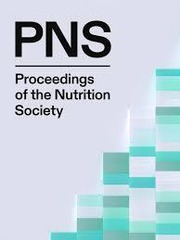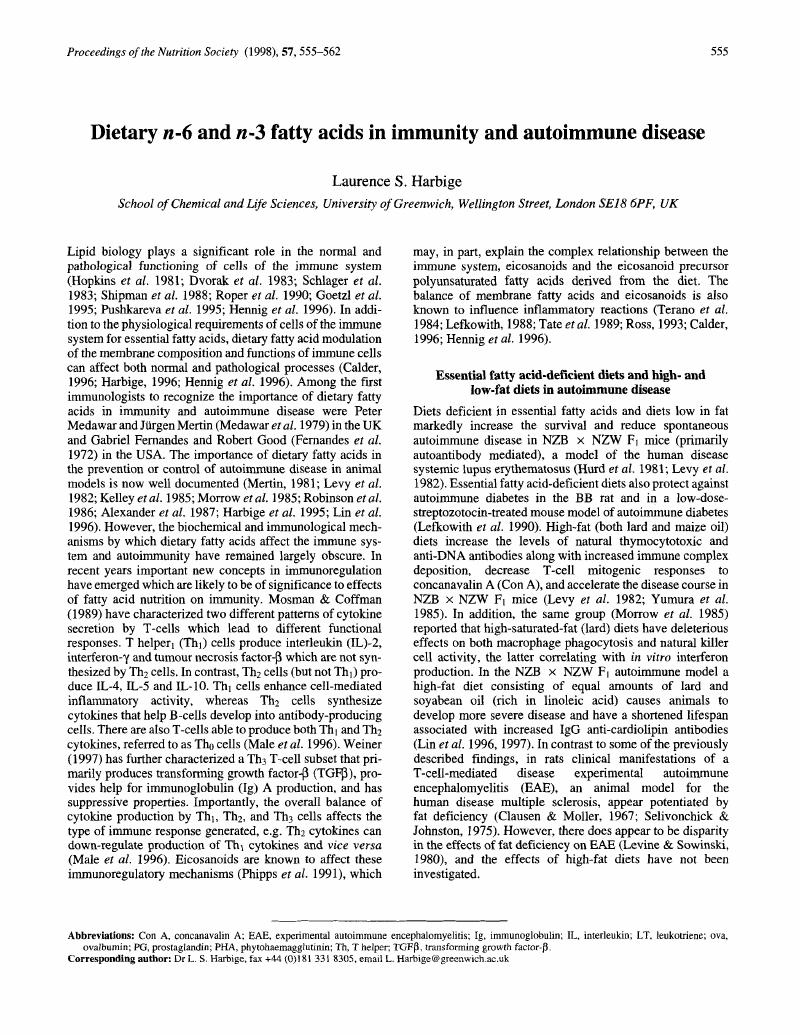Crossref Citations
This article has been cited by the following publications. This list is generated based on data provided by Crossref.
Suchner, U.
Kuhn, K. S.
and
Fürst, P.
2000.
The scientific basis of immunonutrition.
Proceedings of the Nutrition Society,
Vol. 59,
Issue. 4,
p.
553.
Fürst, P.
and
Kuhn, K.S.
2000.
Fish oil emulsions: what benefits can they bring?.
Clinical Nutrition,
Vol. 19,
Issue. 1,
p.
7.
Harbige, L S
Layward, L
Morris-Downes, M M
Dumonde, D C
and
Amor, S
2001.
The protective effects of omega-6 fatty acids in experimental autoimmune encephalomyelitis (EAE) in relation to transforming growth factor-beta 1 (TGF-β1) up-regulation and increased prostaglandin E2 (PGE2) production.
Clinical and Experimental Immunology,
Vol. 122,
Issue. 3,
p.
445.
Calder, Philip C.
2001.
The ratio of n-6 to n-3 fatty acids in the diet: Impact on T lymphocyte function.
European Journal of Lipid Science and Technology,
Vol. 103,
Issue. 6,
p.
390.
Madani, Sihem
Hichami, Aziz
Legrand, Alain
Belleville, Jacques
and
Khan, Naim Akhtar
2001.
Implication of acyl chain of diacylglycerols in activation of different isoforms of protein kinase C.
The FASEB Journal,
Vol. 15,
Issue. 14,
p.
2595.
Heinrich, J.
Hölscher, B.
Bolte, G.
and
Winkler, G.
2001.
Allergic sensitization and diet: ecological analysis in selected European cities.
European Respiratory Journal,
Vol. 17,
Issue. 3,
p.
395.
Denys, Anne
Hichami, Aziz
and
Khan, Naim Akhtar
2001.
Eicosapentaenoic acid and docosahexaenoic acid modulate MAP kinase (ERK1/ERK2) signaling in human T cells.
Journal of Lipid Research,
Vol. 42,
Issue. 12,
p.
2015.
Harbige, Laurence S.
and
Fisher, Benjamin A. C.
2001.
Dietary fatty acid modulation of mucosally-induced tolerogenic immune responses.
Proceedings of the Nutrition Society,
Vol. 60,
Issue. 4,
p.
449.
Anderson, Michele
and
Fritsche, Kevin L.
2002.
(n-3) Fatty Acids and Infectious Disease Resistance.
The Journal of Nutrition,
Vol. 132,
Issue. 12,
p.
3566.
Calder, P. C.
Yaqoob, P.
Thies, F.
Wallace, F. A.
and
Miles, E. A.
2002.
Fatty acids and lymphocyte functions.
British Journal of Nutrition,
Vol. 87,
Issue. S1,
p.
S31.
Raison, Charles L.
Gumnick, Jane F.
and
Miller, Andrew H.
2002.
Hormones, Brain and Behavior.
p.
209.
Wynn, Susan G.
and
Marsden, Steve
2003.
Manual of Natural Veterinary Medicine.
p.
265.
Shimizu, T.
Suzuki, M.
Lee, T.
Igarashi, J.
Kaneko, K.
and
Yamashiro, Y.
2003.
Effects of n-3 polyunsaturated fatty acids on indomethacin-induced changes in eicosanoid production and blood flow in the gastric mucosa of rats.
Prostaglandins, Leukotrienes and Essential Fatty Acids,
Vol. 69,
Issue. 1,
p.
33.
Harbige, Laurence S.
2003.
Fatty acids, the immune response, and autoimmunity: A question of n−6 essentiality and the balance between n−6 and n−3.
Lipids,
Vol. 38,
Issue. 4,
p.
323.
Shireman, R.
2003.
Encyclopedia of Food Sciences and Nutrition.
p.
2169.
Bowling, Allen C.
and
Stewart, Thomas M.
2003.
Current complementary and alternative therapies for multiple sclerosis.
Current Treatment Options in Neurology,
Vol. 5,
Issue. 1,
p.
55.
Pérez, Jordi
Ware, Mark A.
Chevalier, Stephanie
Gougeon, Rejeanne
Bennett, Gary J.
and
Shir, Yoram
2004.
Dietary fat and protein interact in suppressing neuropathic pain-related disorders following a partial sciatic ligation injury in rats.
Pain,
Vol. 111,
Issue. 3,
p.
297.
Zhang, Meijuan
and
Fritsche, Kevin L.
2004.
Fatty acid-mediated inhibition of IL-12 production by murine macrophages is independent of PPARγ.
British Journal of Nutrition,
Vol. 91,
Issue. 5,
p.
733.
Madani, Sihem
Hichami, Aziz
Charkaoui-Malki, Mustapha
and
Khan, Naim A.
2004.
Diacylglycerols Containing Omega 3 and Omega 6 Fatty Acids Bind to RasGRP and Modulate MAP Kinase Activation.
Journal of Biological Chemistry,
Vol. 279,
Issue. 2,
p.
1176.
Bazinet, Richard P.
Douglas, Holly
McMillan, Ewen G.
Wilkie, Bruce N.
and
Cunnane, Stephen C.
2004.
Dietary 18:3ω3 influences immune function and the tissue fatty acid response to antigens and adjuvant.
Immunology Letters,
Vol. 95,
Issue. 1,
p.
85.



